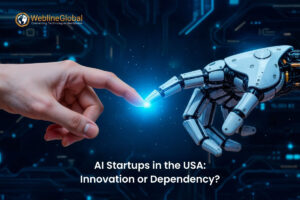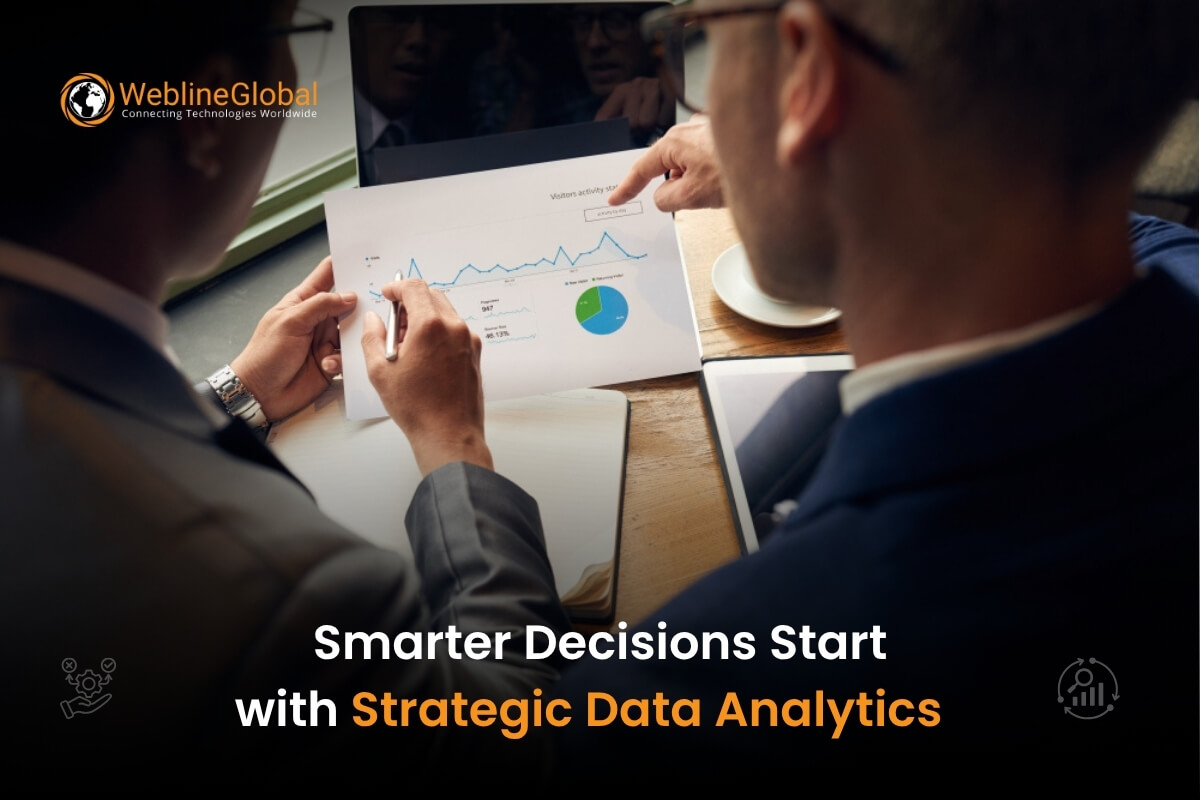
Businesses can’t afford to ignore data anymore. If you’re not using analytics to guide your decisions, you’re falling behind. It’s that simple. In other words, data isn’t just numbers; it’s your competitive edge. Companies that ignore analytics risk are getting left behind. The choice is clear: adapt or lose ground. With the rise of enterprise data analytics, organizations can harness AI development services for structured and unstructured data to drive efficiency, innovation, and growth.
This blog explores how strategic data analytics frameworks empower businesses to make data-driven decision-making a core part of their operations. We’ll also examine the role of AI-powered decision-making in enhancing accuracy and speed while reducing human bias.
Want to make smarter, data-driven decisions that fuel enterprise growth?
Why Data Analytics for Decision Making is Critical for Enterprises
Businesses shift from reactive to proactive decision-making by integrating strategic data analytics to use frameworks that align insights with enterprise goals. This capability fosters innovation and creates a resilient, agile decision-making culture.
Data analytics is essential for modern enterprises aiming to make faster, more informed decisions. It transforms raw data into actionable insights, enabling leadership to anticipate changes, manage risks, and uncover opportunities that drive sustainable business growth.
Key benefits of data analytics for decision making include:
- Improved accuracy in forecasting and risk assessment: Data analytics leverages historical trends and predictive modeling to minimize uncertainty. Enterprises can more reliably forecast sales, demand, and potential disruptions, leading to smarter financial planning and risk management strategies.
- Enhanced operational efficiency through real-time insights: Real-time dashboards and automated reporting streamline operations by identifying bottlenecks and inefficiencies instantly. This empowers teams to respond quickly to issues and continuously improve internal workflows and output.
- Better customer personalization by analyzing behavioral trends: By analyzing customer preferences, purchase history, and engagement patterns, companies can tailor marketing and product offerings. This leads to increased satisfaction, loyalty, and conversion rates across digital and in-person touchpoints.
- Cost reduction by identifying inefficiencies: Data analytics uncovers wasteful processes, underperforming assets, or redundant tasks. Enterprises can reallocate resources more effectively, optimize spending, and significantly reduce operational costs without sacrificing performance.
Key Frameworks for Strategic Data Analytics
Strategic data analytics frameworks provide a repeatable, scalable way for enterprises to extract value from data. These models ensure every step, from identifying business goals to deploying insights, is aligned with broader organizational strategy and decision-making needs.
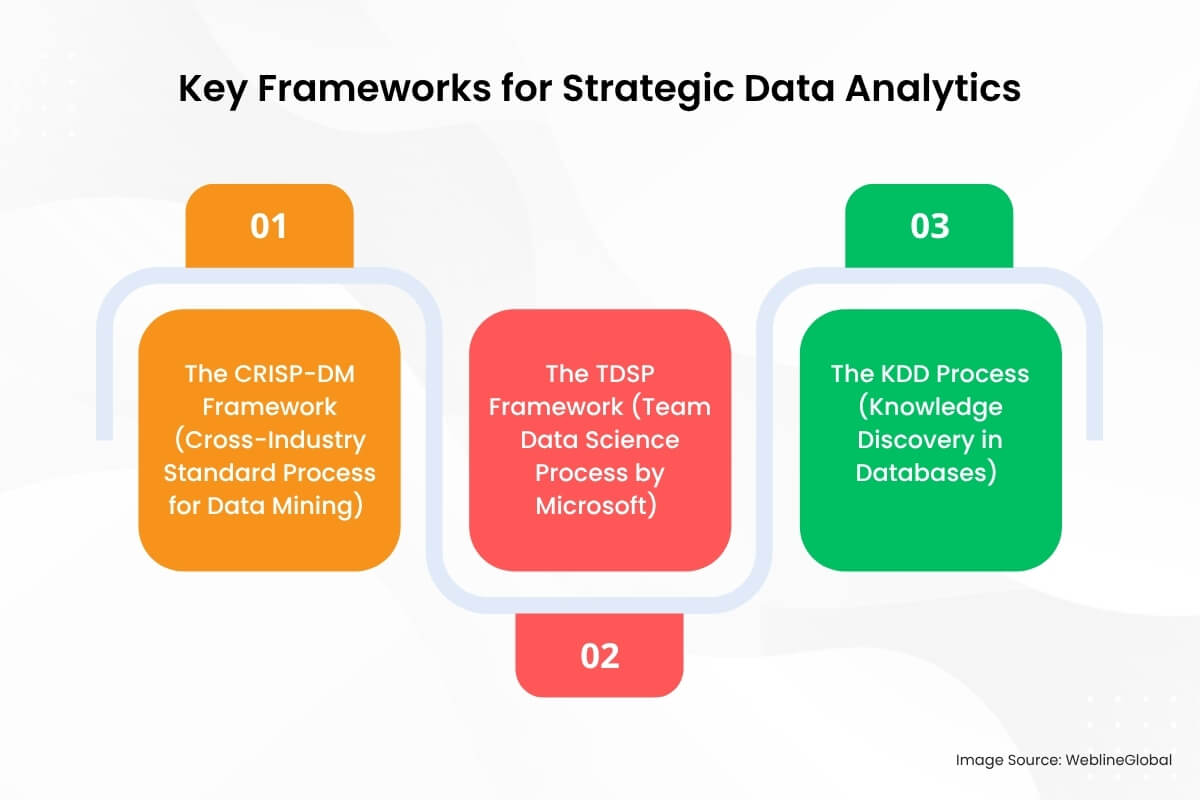
1. The CRISP-DM Framework (Cross-Industry Standard Process for Data Mining)
CRISP-DM is a foundational framework that guides enterprises through each stage of the data analytics lifecycle. Its clear structure promotes consistency, transparency, and actionable outcomes across data-driven decision-making initiatives.
Such frameworks ensure that enterprise data analytics projects are systematic and actionable. Also, they are capable of supporting smart, strategic decisions at every level of the organization.
- Business Understanding: Define objectives: This phase focuses on understanding enterprise goals and aligning analytics objectives with them. A clear problem definition ensures that analytical efforts serve specific strategic priorities and lead to relevant, impactful outcomes.
- Data Understanding: Collect and explore data: Data is gathered from various sources and assessed for quality, relevance, and initial insights. This step helps identify potential challenges early, such as missing values or outliers, ensuring smoother downstream analysis.
- Data Preparation: Clean and transform data: Raw data is refined, cleansed, and organized to ensure consistency and accuracy. This involves normalization, formatting, and feature engineering to make datasets suitable for modeling and reliable interpretation.
- Modeling: Apply algorithms for insights: Analytical models are built using machine learning or statistical techniques. The goal is to uncover patterns and relationships that inform enterprise decisions, such as predictive sales trends or risk scores.
- Evaluation: Validate findings: The model’s effectiveness is measured against business objectives. Enterprises assess accuracy, performance, and usefulness, ensuring the insights generated are valid and can directly support decision-making.
- Deployment: Implement insights into business processes: Final insights are integrated into day-to-day operations, dashboards, or automated systems. This allows decision-makers to act on real-time intelligence and embed data-driven processes across the enterprise.
2. The TDSP Framework (Team Data Science Process by Microsoft)
TDSP is tailored for enterprises integrating AI and machine learning into their decision-making strategies. It emphasizes collaboration, agile execution, and rapid iteration, making it ideal for dynamic business environments requiring scalable, data-driven innovation. This iterative approach helps enterprises refine their strategic data analytics models continuously, promoting agility and long-term value creation.
- Business and Data Understanding: This phase ensures clarity on business goals and identifies the data sources required to address them. Teams collaborate to define success criteria, build hypotheses, and scope the analytical approach for maximum impact.
- Model Development & Deployment: Data scientists build, test, and refine machine learning models. Once validated, these models are deployed in production environments, enabling real-time decision-making across departments and customer-facing platforms.
- Customer Acceptance & Feedback Integration: Stakeholders review model outputs and provide feedback. Insights are adjusted based on user input and business needs, ensuring that analytics remain aligned with real-world enterprise objectives and customer expectations.
3. The KDD Process (Knowledge Discovery in Databases)
The KDD process provides a systematic method for discovering hidden patterns in large datasets. It’s especially useful for enterprises handling complex or unstructured data, enabling the extraction of actionable insights at scale.
- Data Selection: Identify relevant data: The process begins with choosing data that is both relevant to the business problem and suitable for analysis. This step narrows the focus and enhances the efficiency of subsequent tasks.
- Preprocessing: Remove noise: Data is cleaned to remove errors, inconsistencies, and irrelevant information. This improves data quality and ensures that models built later are based on accurate, reliable inputs.
- Transformation: Convert data into analyzable formats: Selected data is reformatted, normalized, or aggregated into structures that facilitate deeper analysis. This step bridges the gap between raw data and usable insight generation.
- Data Mining: Apply AI/ML techniques: Algorithms are used to detect meaningful patterns, trends, or anomalies. Techniques such as clustering, classification, or regression help extract insights that inform enterprise-level decisions.
- Interpretation: Turn insights into business actions: The final step involves translating technical findings into actionable recommendations. Stakeholders can then use these insights to optimize operations, refine strategies, or uncover new business opportunities.
Confused about which data analytics framework suits your business best?
How AI-Powered Decision Making Enhances Data Analytics
Artificial Intelligence significantly amplifies the capabilities of enterprise data analytics. AI enables faster and more accurate decision-making by automating complex tasks. Its integration into analytics frameworks transforms static reports into dynamic, real-time strategic tools that drive competitive advantage.
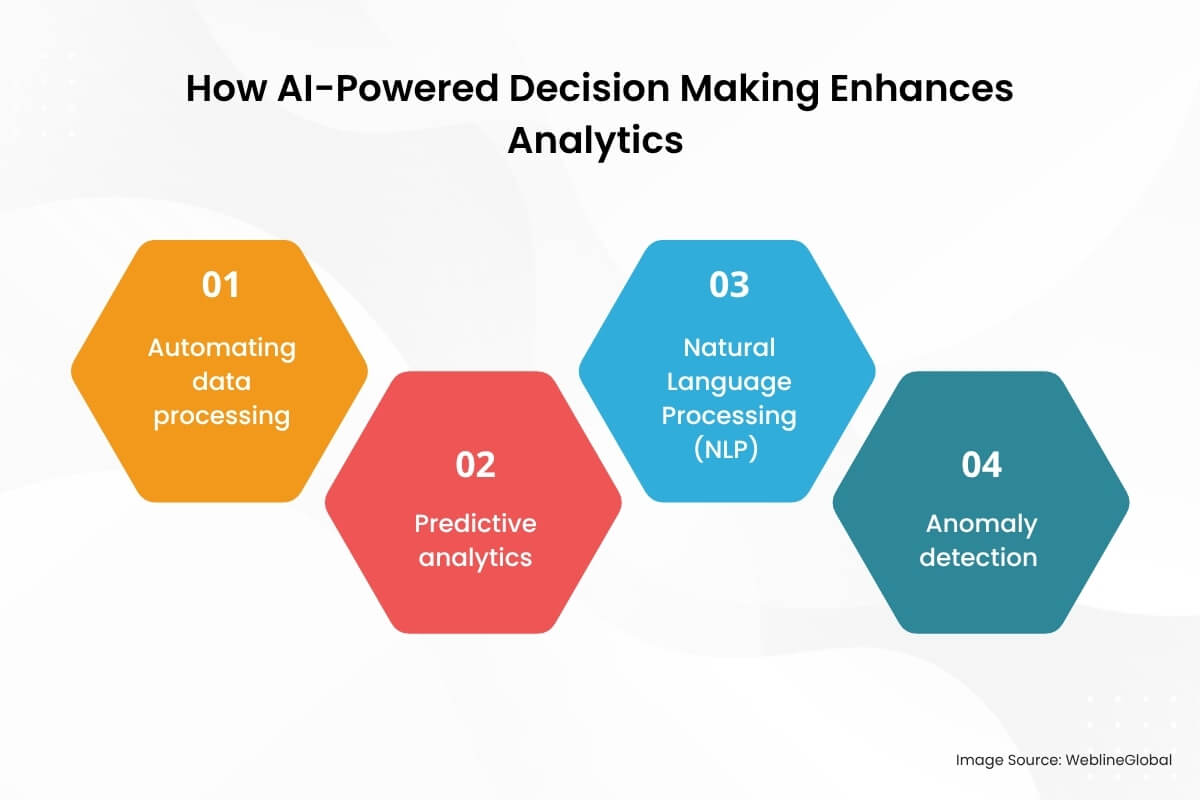
Automating data processing
It reduces manual effort. AI streamlines the collection, cleansing, and integration of data from multiple sources. This minimizes manual labor, accelerates workflows, and ensures that analytics teams can focus on interpreting insights rather than data wrangling.
Predictive analytics
It helps forecast trends with high accuracy. Machine learning algorithms analyze historical data to project future outcomes. This allows enterprises to anticipate customer needs, market shifts, or operational issues, enabling proactive planning and better allocation of resources.
Natural Language Processing (NLP)
It helps you extract insights from unstructured data. NLP enables systems to interpret and analyze human language from sources like emails, customer reviews, and support tickets. This expands the data pool and uncovers sentiment, preferences, and pain points at scale.
Anomaly detection
It is possible to identify risks in real time. AI systems continuously monitor data to detect deviations from normal patterns. Whether it’s fraud, system failures, or supply chain disruptions, enterprises can respond immediately, reducing risk and protecting assets.
Overall, AI can do wonders for your business in making smarter decisions. For example, retail giants use AI to dynamically adjust inventory based on real-time demand forecasts. In finance, AI-driven analytics proactively detect fraud by flagging unusual transaction behaviors, improving both security and customer trust.
Best Practices for Successful Enterprise Data Analytics
For enterprises to gain measurable value from data analytics, strategic alignment and disciplined execution are essential. These best practices ensure that data initiatives are scalable, insights are actionable, and decision-making is both agile and informed.
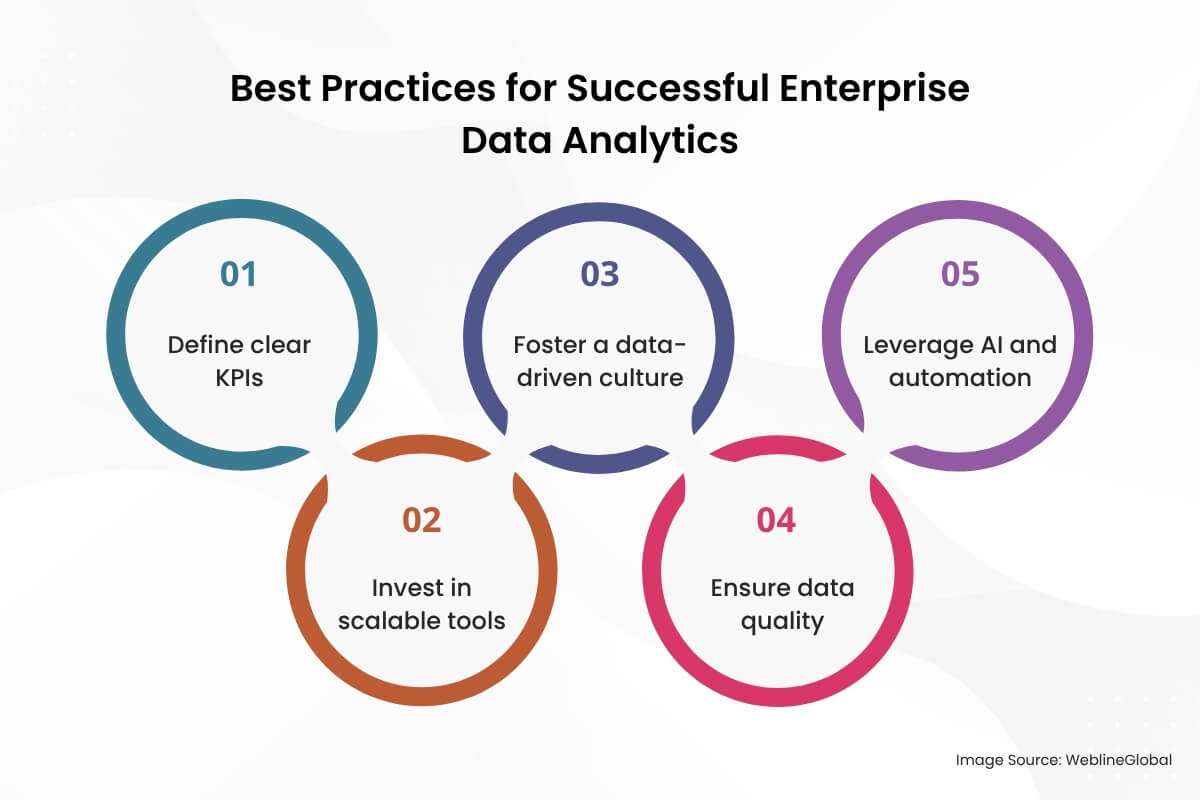
Define clear KPIs
You need to align analytics with business goals. Key Performance Indicators (KPIs) should directly support enterprise objectives. Clearly defined metrics ensure analytics teams focus on what matters most—whether that’s increasing customer retention, improving operational efficiency, or driving revenue growth.
Invest in scalable tools
These are cloud-based platforms like AWS, Google BigQuery. Scalable infrastructure enables enterprises to manage growing data volumes effortlessly. Cloud-based tools provide flexibility, real-time processing, and cost-efficiency, empowering teams to run complex analytics without limitations on storage or compute power.
Foster a data-driven culture
It’s essential to train teams on data analytics for decision making. A successful analytics strategy requires more than tools—it needs people who understand and trust data. Ongoing training and cross-functional collaboration help embed data literacy and support informed decisions at every organizational level.
Ensure data quality
It happens through clean and accurate data, as it is foundational. Poor data quality leads to misleading insights. Enterprises must implement robust data governance practices, including validation, deduplication, and standardization, to maintain the integrity and reliability of their analytics output.
Leverage AI and automation
Enhance AI-powered decision making for speed and precision. Integrating AI and automation accelerates insight generation and reduces human error. From predictive modeling to real-time alerts, automated systems enable faster, more precise decisions that scale across the enterprise.
Future Trends in Strategic Data Analytics
As technology advances, strategic data analytics in enterprises is evolving toward greater automation, real-time intelligence, and personalization. Emerging trends are reshaping how data is collected, analyzed, and applied to drive smarter, faster business decisions.
Augmented analytics
AI-driven insights with minimal human intervention are in trend. Augmented analytics automates data preparation, analysis, and visualization. By reducing the need for manual input, it empowers business users to access complex insights quickly, streamlining decision-making across all departments.
Edge analytics
The trend is also of real-time processing at data sources (IoT devices). Edge analytics processes data directly at the point of creation, like sensors or IoT devices, enabling immediate insights. This is critical for industries such as manufacturing and logistics, where timing and responsiveness are essential.
Explainable AI (XAI)
Transparent AI-powered decision-making is something you cannot ignore today. As AI becomes more central to decisions, explainability is key. XAI ensures that stakeholders understand how models reach conclusions, which builds trust, supports compliance, and enables informed oversight of automated decisions.
Hyper-personalization
Customized customer experiences using data-driven decision making is also a trend. By leveraging behavioral, transactional, and contextual data, enterprises can deliver highly tailored content and services. Hyper-personalization enhances customer satisfaction and loyalty by addressing individual needs in real time.
Strategic Decision for Sustainable Growth
Data analytics for decision making is the backbone of modern enterprises. Businesses can unlock actionable insights, optimize operations, and drive innovation by adopting strategic data analytics frameworks.
The integration of AI-powered decision-making further enhances accuracy and efficiency, ensuring companies stay ahead in a data-centric world. For enterprises looking to thrive, getting professional enterprise data analytics services in the US from WeblineGlobal is no longer optional. It’s imperative for sustainable growth and data-driven decision making.
Social Hashtags
#StrategicDataAnalytics #DataAnalytics #AIforBusiness #DataDrivenDecisions #EnterpriseAnalytics #AIPoweredInsights #BusinessIntelligence #DigitalTransformation #BigDataSolutions #PredictiveAnalytics #EnterpriseGrowth #StrategicDecisions #WeblineGlobal
Ready to unlock business success through AI-powered strategic analytics?
